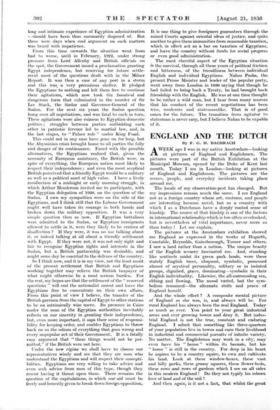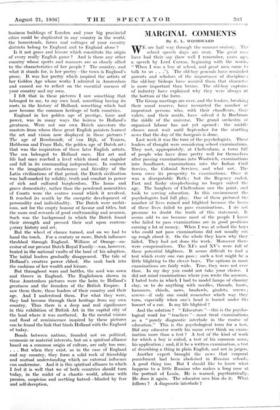ENGLAND AND THE DUTCH
By F. G. H. BACHRACH AWEEK ago I was in my native Amsterdam—looking at pictures of England and Englishmen. The pictures were part of the British Exhibition at the Municipal Museum, opened by the Duke of Kent last month. Today I am in London—looking at pictures of England and Englishmen. The pictures are the scenes, people, and everyday incidents taking place around me.
The locale of my observation-post has changed. But my impressions remain much the same. I see England not as a foreign country whose art, customs; and people are interesting because novel, but as a country with which I as a Dutchman have a deeply rooted sense of kinship. The source of that kinship is one of the factors in international relationship which is too often overlooked, but is nevertheless of vital importance, never more so than today ! Let me explain.
The pictures at the Amsterdam exhibition showed me England as expressed in the works of Hogarth, Constable, Reynolds, Gainsborough, Turner and others. I saw a land rather than a nation. The unique beauty of the English scenery fascinated me. And, standing like sentinels midst its green park lands, were these stately English trees, eloquent, symbolic, possessed almost of mystical personality, solitary or in isolated groups, dignified, grave, dominating symbolic in their English individuality. Likewise, the all-surrounding sea, ebbing and flowing. The mood varied, but the sym- bolism remained—the alternate strife and peace of England herself.
And the whole effect ? A composite mental picture of England as she was, is, and always will be. For rural England has always been the real England. Today as much as ever. You point to your great industrial areas and ever growing towns and deny it. But indus- trial England is not the true, constant and enduring England. I admit that something like three-quarters of your population live in towns and earn their livelihood in industrial and commercial pursuits of infinite variety. No matter. The Englishman may work in a city, may even have his " house " within its bounds, but his " home " is still in the country. For deep in his heart he aspires to be a country squire, to own and cultivate his land. Look at these window-boxes, these vast and hilly parks, these grassy squares, these flower-beds, these rows and rows- of gardens which I see on all sides in this modern England ! Do they not typify his inborn love of land and of the soil ? • And then again, is it not a fact, that whilst the great business buildings of London and your big provincial cities could be duplicated in any country in the world, the homesteads, farms and cottages of your country districts belong to England and to England alone ?
Is it not grass and leisure which constitute the origin of every really English game ? And is there any other country whose sports and manners are so closely allied to the characteristics of her people ? The country, and what it stands for, is her poetry—the town is England's prose. It was her poetry which inspired the artists of her Golden Age whose works I admired in Amsterdam and caused me to reflect on the essential oneness of your country and my own.
I felt that in these pictures I saw something that belonged to me, to my own land, something having its roots in the history of Holland, something which had now become the common heritage of both countries.
England in her golden age of prestige, fame and power, was in many ways the heiress to Holland's greatness. Were not our own Dutch ancestors the masters from whom these great English painters learned the- art and vision now displayed in these pictures ? Tile age of Rerhbrandt, of van Dijk, of Teniers, Hobbema and Frans Hats, the golden age of Dutch art: that was the inspiration of these later English artists. The sea belonged to Holland once. Her art and life had once reached a level which stood out singular and full in its commanding independence. In contrast to the imaginative exuberance and frivolity of the Latin civilisations of that period, the Dutch civilisation was hall-marked by solidity, truth and comfort in power of rich and cultured burgherdom. The home and grave domesticity, rather than the powdered nonentities of Courts were the centres round which it revolved. It reached its zenith by the energetic development of personality and individuality. The Dutch were ambit- ious, not for the empty honour of favour and titles, but the more real rewards of good craftmanship and acumen. Such was the background in which the Dutch found their strength and pressed their seal upon contem- porary history and art.
But the wheel of chance turned, and on we had to hand the torch. For a century or more, Dutch influence throbbed through England. William of Orange—an- cestor of our present Dutch Royal Family—was, however, buried in the national vaults of the land of his adoption. The initial leaders gradually disappeared. The tide of Holland's creative power ebbed. She sank back into the cushions of her wealth and leisure.
But throughout wars and battles, the seed was sown and throve in England. The Englishmen shown in these Amsterdam pictures were the heirs to Holland's greatness and the founders of the British Empire. I saw them there, these leaders of their country and their age. And I understood them. For what they were, they had become through their heritage from my own country. Thus there is a deep and real significance in this exhibition of British Art in the capital city of the land where it was mothered. In the mental visions and flood of reminiscence inspired by these pictures can be found the link that binds Holland with the England of today.
Bonds between nations, founded not on political, economic or material interests, but on a spiritual alliance based on a common origin of culture, are only too rare. . . . But when they exist, as in the case of England and my country, they form a solid 'rock of friendship and mutual understanding which no external influence can undermine. And it is this spiritual alliance to which I feel it is well that we of both countries should turn today, in the midst of a chaotic world, aflame with passion, suspicion and seething hatred—blinded by fear and self-deception.







































 Previous page
Previous page